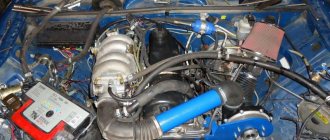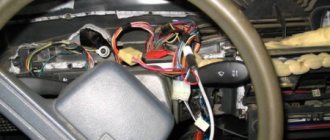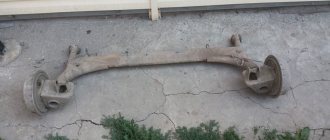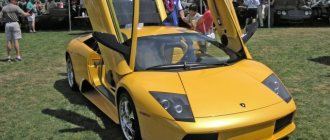Hi all! I think you have repeatedly seen cars with a certain structure on the hood designed to capture air and build up pressure, thereby increasing the power of the internal combustion engine. Here we are talking about a mechanical air blower for a car.
Today I want to talk about it in more detail. And you can decide for yourself whether it’s worth buying it, including second-hand on Avito, or trusting specialized specialists. Or maybe this is completely unnecessary for you, and it will just be interesting to understand the features and operating principle of the supercharger.
I would like to say right away that it is impossible to make such a thing for a car from a vacuum cleaner, even if it is a VAZ 2114. But you can install a supercharger on the carburetor and injector.
000_MOTO_1110_072
The advantages of centrifugals include simplicity of design, compactness and low weight.
There is also no strict need to use intercoolers, since they heat the air much less than vane superchargers and turbochargers. The advantages of centrifugals include simplicity of design, compactness and low weight. There is also no strict need to use intercoolers, since they heat the air much less than vane superchargers and turbochargers.
The idea of increasing engine power by pushing an additional portion of air and fuel into it is as old as the world. And this can be achieved if a pressure greater than atmospheric pressure is created at start-up. This is what superchargers are used for. There are many models, but in “Moto” Nos. 8 and 9 (Horex and me with my crazy “gold”) we talked about centrifugal ones. In short, these are high-speed fans, and, figuratively, “boy vacuum cleaners.”
The very idea of forced air injection into the cylinders was proposed shortly after the invention of the internal combustion engine itself. Already in 1885, Gottlieb Daimler received a German patent for the supercharger. The idea was that some external fan, pump or compressor would force an increased charge of air into the engine. In 1902, in France, Louis Renault patented a design for a centrifugal supercharger. But after the release of several cars, all work in this direction was stopped - the imperfection of technologies and materials tipped the scales with more “against” than “for”. The abbreviation PCN (driven centrifugal supercharger) took root in the everyday life of engine mechanics in the 30s of the twentieth century - however, only in aviation. The introduction of monitoring stations made it possible to kill two birds with one stone: to increase specific power and reduce the drop in power at high altitudes. (As altitude increases, the density of air decreases; accordingly, less of it enters the engine, and to maintain power, the oxidizer has to be forced in.) All superchargers installed on internal combustion engines can be divided into two main groups based on their operating principle: centrifugal and positive displacement. And according to the type of drive - drive (driven by the crankshaft) and gas turbine (using the energy of exhaust gases).
What is a monitoring station? Let's plunge into childhood and remember the spinning top. What happens if you splash water on top of a spinning top? That's right, water will splash around under the influence of inertial forces (centrifugal force), and the spinning top will remain almost dry. Likewise, in a centrifugal supercharger, the role of the spinning top is played by the impeller, and the role of water is played by air molecules. I think that as a child, everyone looked inside a vacuum cleaner and saw behind the grate of the dust collector compartment a strange disk with blades and a nut in the middle. This is the simplest centrifugal supercharger, only it works for suction, and not for creating excess pressure. What happens if you connect the hose to the vacuum cleaner, but from the side from which it blows air? And if it is also introduced into the engine intake...
The impeller of a real CN has a rather complex cone-shaped shape, and the blades have a complex profile and bend. The performance and efficiency of the entire supercharger depends on their geometry. (For example, the larger the diameter of the impeller, the more pressure it can produce at the same speed, but at the same time it consumes more power; or when the number of blades increases, the pressure increases, but the performance decreases.) The air, passing through the air channel into the supercharger, falls on the radial blades of the impeller. The blades throw it to the periphery of the casing through a thin slot. There, the air is slowed down in a snail-shaped diffuser, its speed drops, and the pressure rises.
In fact, the monitoring station is half of a turbocharger already familiar in the world, but instead of the “hot” (turbine) part, it is mechanically driven from the crankshaft. Due to the very principle of operation, the centrifugal supercharger has one significant drawback. To operate effectively, the impeller must rotate not just quickly, but very quickly. The pressure produced by a centrifugal compressor is proportional to the square of the impeller speed. Accordingly, hence the main disadvantage of centrifugals: a narrow operating range. But this theoretical minus in practice turns out to be a plus. After all, if the supercharger forcibly pumps air into the engine all the time, this will lead to an increase in traction throughout the entire speed range, and it will be difficult to cope with such “fruit” at the bottom. It’s another matter if excess pressure in the intake begins to arise at medium speeds and reaches a peak at high speeds, when the filling of the cylinders deteriorates due to friction losses on the intake tract of the air-fuel mixture (this causes the downward tail of the torque curve in the high speed range at many dino graphs). The centrifugal coolly “inflates” the tops, helping the mixture enter the cylinders in the required volume. That is why there is no need to turn off the supercharger at low speeds, as is necessary with positive displacement compressors.
Concept, pros and cons of a mechanical supercharger Supercharger
Mechanical supercharging is the process of increasing the pressure of a certain mixture at the engine inlet to increase the mass of the combustible mixture in the cylinder to increase power relative to a unit of engine volume.
A supercharger, also known as a Roots compressor, is a mechanical supercharger that uses the power of the crankshaft for its own drive. It is the main element of mechanical supercharging.
The main functional advantage of a supercharger is that it can pump air at minimum speeds, absolutely without delay, while the increase in boost force is strictly proportional to engine speed.
The main disadvantage of a supercharger is that it steals part of the engine power for its own drive.
At the moment, mechanical superchargers are practically not used. They were replaced by turbochargers (turbochargers). With rare exceptions, they are sold and installed on passenger cars if it is necessary to make an increase in power, so as not to change the engine design.
On average, the use of a mechanical supercharger provides an increase in engine power by up to 50% and torque by 30%. At the same time, a mechanical supercharger is characterized by significant losses in engine power due to the energy consumed to drive it. In different mechanical superchargers they can be up to 30%.
004_MOTO_1110_072
The size of the gap between the impeller blades and the housing is the main parameter affecting the efficiency of the compressor.
The size of the gap between the impeller blades and the housing is the main parameter affecting the efficiency of the compressor.
Everything is great, but centrifugal engines also have undeniable shortcomings. The main thing is that you need to spin the impeller to crazy speeds, so you have to use a step-up gearbox, which has 50–150 thousand rpm on the output shaft (for some monitoring stations this figure reaches 250 thousand!). Rare bearings and seals can withstand this, and therefore the issue of service life and efficiency is often more pressing than increasing power. And the overall efficiency of the engine is reduced due to the fact that the supercharger sucks power directly from the crankshaft. But every hole of problems can be climbed out of by a thin rope of technological solutions. For example, BRP on its sports jet skis drives the supercharger directly from the crankshaft flywheel gear, and is saved from gear-damaging jerks by using a friction damper on the supercharger shaft. Yamaha drives the snail through an intermediate shaft. If we look at the tuning units, we see that, for example, Rotrex (which is adored by European motorcycle tuners, including yours truly) uses a friction roller gearbox, in which the impeller shaft is sandwiched between the planetary gears and does not require bearings. The Americans from ProCharger, having brought a kit to the market for Harley-Davidson, focus on the precision of manufacturing the gearbox; their colleagues from Powerdyne like to “supercharge” snowmobiles and use an additional belt drive as a multiplier.
And again we remember our childhood, and also, who remembers, physics. When we inflated our bicycles, mopeds and motorcycles with pumps, remember how the hose going to the wheel got hot? That's right, more pressure means higher temperature, higher temperature means less air density, which means less oxygen molecules per unit volume. To compensate for this decrease in density, the compressed air must be cooled. How? The same as antifreeze or oil - in the radiator, or more precisely, in the intercooler (in scientific terms, charge air cooler). Intercoolers are mainly of the air-to-air type (a seemingly simple radiator with thicker channels) and air-to-liquid, when between the compressor and the intake manifold there is a compact “radiator in reverse”, which takes heat from the compressed air into the liquid, and then discharges it into atmosphere through an additional radiator.
But still, why not turbo? After all, in the world of cars, more and more manufacturers are equipping their cars with turbocharging. Alas, the “turbo” not only increases power, but also creates resistance at the exhaust, greatly heats the air at the intake not only due to its compression, but also due to the proximity of the hot exhaust manifold; in addition, the engine experiences “turbo lag” or “turbo lag” (when the impeller, having no mechanical connection with the crankshaft, does not have time to spin up after the throttle is opened, which causes a short-term dip in traction - the complete antithesis of the expression “follow the handle”). Because of all of the above, the turbo motorcycles that appeared in the early 80s (say, the Yamaha XJ650 Turbo) failed in the market, and now neither the designers of serial vehicles nor the tuners are in a hurry to “stick a snail” into motorcycle engines. The exception is drag racing equipment and other cars for record straight races; there, “turbo lag” is usually compensated by “anti-lag” (a system that allows you to sharply increase the temperature of the gases in front of the turbine - wild barbarity, justified only by complete disregard for the resource). However, let’s not say “never” - the French from Yam74, after experimenting with the Tmax monitoring station, eventually switched to the “turbo”, and not without success. Therefore, we will wait for developments.
Scroll compressors (superchargers)
Leon Creux applied for a patent in 1905 to create a steam engine, which, after 10 years of development, became a compressor with two spiral turns, eight jets instead of four, an outer and inner chamber located on the sides with a rotation of 180 degrees. But at that time it was very early to think about mass production of compressors. There were no materials capable of withstanding the operating temperature and no equipment for precise processing of parts. The latter is a decisive factor, since any error in the manufacture of parts, quality or surface structure could lead to a significant loss of efficiency and rapid breakdown of the entire engine and the supercharger in particular. Because of this, its use in mechanical engineering began much later.
in the mid-80s, she began to actively experiment with unusual scroll compressors, best known as G-lader, installing them on Golf, Passat, Polo, and Carrado models. Although now this direction has already been curtailed, the work of VW engineers in it will never be forgotten. A number of (mostly German) manufacturers continue to use their developments by installing scroll compressors in their cars.
Advantages of a scroll compressor:
- High efficiency -76%
- Good seals and, as a result, good performance at low speeds.
- Low noise level
008_MOTO_1110_072
Rotrex disassembled (top) and its oil system (bottom).
The planetary gearbox with smooth rollers operates mainly due to a special oil circulating through the system. Therefore, unlike their gear counterparts, which are lubricated from the general engine lubrication system, Rotrex has its own oil circuit with a radiator and filter. Rotrex disassembled (top) and its oil system (bottom). The planetary gearbox with smooth rollers operates mainly due to a special oil circulating through the system. Therefore, unlike their gear counterparts, which are lubricated from the general engine lubrication system, Rotrex has its own oil circuit with a radiator and filter.
009_MOTO_1110_072
A homemade supercharger, built on the basis of a domestic turbocharger, in which the “hot” part was replaced by a gearbox.
The notch on the impeller is a consequence of balancing: the metal was cut not from the blade, but from where the notch would not create turbulence in the air flow. Our “Kulibins” used an “inside out” gearbox - it’s compact and the oil itself disperses along the teeth due to centrifugal force. The faceplate connects the snail and the gearbox. It also contains a bearing and an impeller shaft seal. A homemade supercharger, built on the basis of a domestic turbocharger, in which the “hot” part was replaced by a gearbox. The notch on the impeller is a consequence of balancing: the metal was cut not from the blade, but from where the notch would not create turbulence in the air flow. Our “Kulibins” used an “inside out” gearbox - it’s compact and the oil itself disperses along the teeth due to centrifugal force. The faceplate connects the snail and the gearbox. It also contains a bearing and an impeller shaft seal.
Driven blowers











